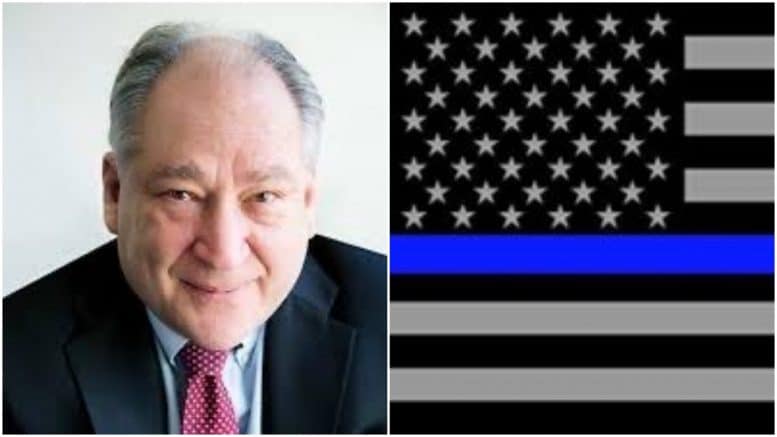A public firestorm began when a local man and his son presented a wooden”thin blue line” flag to Montgomery County Police.
In late October, Montgomery County resident James Shelton brought his young son to the Montgomery County Police 5th District station.
Shelton, a local woodworker, and his son carved a wooden “thin blue line” flag to show their appreciation to Montgomery County Police officers in honor of National First Responders Day.
A “thin blue line” flag is a commonly recognized symbol showcasing the service and sacrifice of American law enforcement officers.
Montgomery County Police tweeted its thanks to Shelton.
Thank you to resident James Shelton, who presented Montgomery County 5th District officers with a wooden American Flag that he had made in recognition of National First Responders Day. The flag will be displayed in the 5th District Station. pic.twitter.com/kbAI32xHkY
— Montgomery County Department of Police (@mcpnews) October 30, 2019
The 5th District’s police officers hung Shelton’s flag inside their Germantown station soon after Shelton and his young son departed.
But Shelton’s gift soon exploded into a national controversy.
Elrich order’s the flag’s removal from police station
Montgomery County Executive Marc B. Elrich (D) ordered Shelton’s flag to be removed from the Germantown police station after some county residents characterized Shelton’s “thin blue line” flag as a “racist symbol” that disrespects the Black Lives Matter movement.
In a public statement, Elrich said the flag “provides a symbol of support to some,” but the flag is “a symbol of dismissiveness to others.”
“Because it is divisive, the flag will not be posted in the 5th District nor in any public space within the Police Department,” Elrich said.
Larry Hogan weighs in
Maryland Gov. Larry Hogan (R) blasted Elrich on social media.
The governor called on Elrich to “immediately reverse” his “terrible decision” and he called on the county executive to apologize “to the police and citizens of Montgomery County.”
Thin Blue Line history
The “Thin Blue Line” dates back to the 19th century when British forces held off Russian cavalry forces in 1854 during the Crimean War.
The British Army’s traditional red uniforms were viewed by the world as a symbol of prestige and robust military power. In traditional linear formation, British forces lined the battlefields of war in what became known as a “Thin Red Line.”
In 1854, the 93rd Highland Regiment of Foot of the British Army stood side-by-side and held strong against Russian forces.
In 1911, poet Nels Dickmann Anderson wrote a poem called “The Thin Blue Line.” The phrase was a reference to the blue uniforms worn by the men of the United States Army in the late 18th and 19th centuries.
While no clear date exists as to when American law enforcement began to use the “Thin Blue Line” phrase, the term is believed to have taken off sometime in the 1950s, eventually evolving into a symbol for law enforcement standing “between chaos and order or between criminals and the potential victims of crime.”
The color blue evolved into a nationally recognized symbol for American law enforcement.
A symbol for American law enforcement
Most American law enforcement officers agree that the “thin blue line” symbolizes a sense of uniformity among police officers and their families – regardless of race, sex, gender, and religion.
Police officers believe the flag symbolizes order, crime deterrence, and peace.
The Thin Blue Line Flag
Thin Blue Line USA – a Michigan-anchored company founded with the goal of supporting law enforcement officers through clothing apparel and accessories -brought the “Thin Blue Line” police flag to market, according to the company’s website, in an effort to inspire American support on behalf of law enforcement officers.
The company also supports law enforcement non-profits and law enforcement families affected by the loss of a police officer. The company claims to have “donated over $500,000 to causes supporting law enforcement, veterans, first responders and more.”
In 2014, Thin Blue Line USA redesigned the “Thin Blue Line” law enforcement flag, creating a 13-stripe model that resembles the American flag design. The redesigned flag is said to be used to raise funds for families of fallen law enforcement officers.

Thin Blue Line controversy
The “Thin Blue Line” flag concept took off after it was released in 2014. Supporters of law enforcement, and thousands of American law enforcement officers themselves, proudly display the flag (and other merchandise) to show their support and solidarity on behalf of the law enforcement community.
However, the flag soon became a symbol of controversy amid supporters of the Black Lives Matter movement.
Black Lives Matter (BLM) is an international activist movement that originated in African-American communities that campaigns against – and protests violence -against African Americans, systemic racism, racial profiling, police killings of black men and women, police brutality, racial inequality, and more.
Black Lives Matters has been influential in bringing international media attention, in the form of organized protests, to the deaths of African Americans by police actions, including Freddie Grey, Sandra Bland, Eric Garner, Michael Brown, Tamir Rice, John Crawford III, Walter Scott, Alton Sterling, Philando Castile, Deborah Danner, and many others.
The ‘Thin Blue Line” flag has now become an opposition symbol within the Black Lives Matters movement and within other movements created to highlight systematic injustices as a result of actions taken against African-Americans by law enforcement officers.
During the infamous 2017 Charlottesville, V.A. Unite the Right rally, members of a white nationalist group used the “Thin Blue Line” flag as a symbol to show support for police and opposition to the Black Lives Matter movement. After Charlottesville, more white nationalists and white supremacists began using the “Thin Blue Line” flag in support of law enforcement and police authority.
The Michigan company that is responsible for manufacturing the flag strongly condemned the Charlottesville white nationalists over the use of their flag design, telling USA TODAY, “We reject, in the strongest possible terms, any association of our flag with racism, hatred, and bigotry. To use it in such a way that tarnishes what it and our nation believe in. The thin blue line flag stands for the sacrifice law enforcement officers of this nation make each day. We ask our nation to hold faith with those that defend the thin blue line.”
The National Association of Police Organizations strongly condemned the use of the “Thin Blue Line” during the Charlottesville protests as a symbol of hate and racism, telling USA TODAY in August 2017, “No police department, no official police group would ever go in there and raise their flag for that type of demonstration.”
Local police respond
Elrich, 70, is a former chair of the Montgomery County Council’s Public Safety Committee. He’s well-versed in the community policing model, de-escalation tactics, and racial diversity.
Over the years, Elrich’s relationship with Montgomery County Police crumbled.
A Miner Detail spoke with four separate Montgomery County Police Officers on the condition that their identities be withheld from print.
“Mr. Elrich has no interest in developing a relationship with us,” a Bethesda-based office told A Miner Detail.
“Elrich and [Montgomery County Councilman] Will Jawando (D) hate us. We [MCP] don’t want to work with Elrich when we know he doesn’t have our backs.”
Another Montgomery County Police officer assigned to the Gaithersburg station expressed hope that Elrich could use this brewing controversy as a means to engage Montgomery County Police, and listen to their concerns, in an effort to improve their relationship.
“When Mr. Elrich assumed office last year, we did our best to make no assumptions about his leadership. As time passed, though, the message was clear that Mr. Elrich is disinterested in the day-to-day operations of MCP. He appears to be aloof, and he has not given LEOs much assurance that he’s supportive.”
Another Montgomery County Police officer who spoke to A Miner Detail on background criticized Elrich for “bungling” the Montgomery County Police Chief hiring process.
“From start to finish, Elrich failed on a number of fronts during the police chief hiring process. Marcus Jones should have been a no-brainer, but Elrich wanted someone outside of Montgomery County – Tonya Chapman – who turned out to be a disaster. She withdrew, and he went to his second-best-choice. He sent mixed messages to our commanders throughout the hiring process and he was unprepared to undertake one of the most critical aspects of his job as county executive. We watched this mess in disbelief.”
One other Montgomery County law enforcement official shared a slightly more optimistic view of Elrich, giving him the benefit of the doubt of being a “relatively new” county executive but still expressed disappointment in his decision to disallow the “Thin Blue Line” flag in the District 5 station.
Shelton told ABC 7 on Wednesday that he wanted his son “to be involved so he could see how important it is to give back as well as to help build good character and make a wonderful memory we will always have.” [My son] was so excited to help and even more so when be helped me deliver them.”
A Miner Detail reached out to Shelton for comment on the latest statement from the governor and the evolving controversy.
Questions/Feedback? ryan@aminerdetail.com





